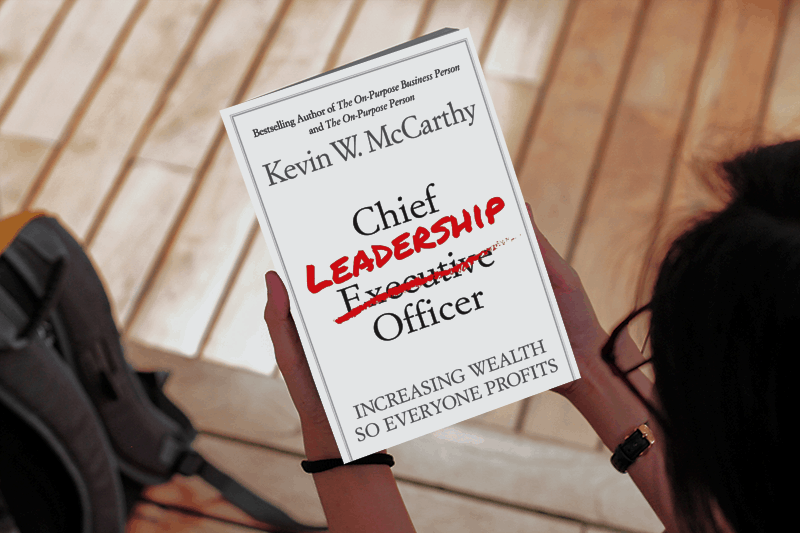
Chief Leadership Officer is a disruptive message to most CEOs… in a good way! CEOs, like CLOs, seek profits. CLO is the most profitable way to be in business provided the CEO is willing to make the tough shift to become a CLO. Learning to do business more completely right builds upon the skills and strengths of a CEO plus it adds the power of purpose and leadership competency with people, especially the CEO.
This message and method of leadership anticipate where business is headed and where you as a CEO and organization want to be regardless of your position in the company. Below, dig into the Prologue and Chapter 1.
Chief Leadership Officer is also available on Audible for your listening pleasure. Listen here.
Prologue
You Run Things
You run things. You make decisions. You manage a P&L. People look to you for direction and answers. You want very satisfied customers. You willingly weigh the risks and the rewards in order to make sound decisions that move the business forward.
You know the feelings of being overwhelmed and low as well as the joys and the highs of success. You persistently pursue improvement. You seek more—a better life, family, team, and customers. You strive to make a difference and make money. You willingly grasp the reigns of the beast called a business because its possibilities are endless.
Amid your inspiration, aspiration, and perspiration lives frustration. Yes, you’re a Chief Executive Officer, even if not in title, because in reality we’re all running something.
Chapter 1
Hey, It’s Just a Cup of Coffee
The task of an executive is not to change human beings.
Rather as the Bible tells us in the parable of the talents, the task is to multiply the performance capacity of the whole
by putting to use whatever strength,
whatever health, whatever aspiration there is in individuals.
Peter F. Drucker
The Effective Executive
Management Consultant, Educator, and Author
1909–2005

Your smartphone rings and up pops the name and image of Chris, a wisecracking good friend and respected CEO colleague. You smile. One can never tell what this spirited guy is up to, but he’s typically fun and interesting.
“Hi, Chris.”
“Drop everything! Join me. Come grab a cup of coffee with an old friend of mine who’s in town for just a couple more hours. He invited me to attend some presentation he did earlier this morning. I was already booked but free in the afternoon. I’m just about to pick him up and then take him to the airport. We’re stopping for a jolt of java at Latte Out Loud, a coffee shop someone at his conference recommended to him. You two will enjoy getting to know one another. You in?”
Scanning your calendar quickly you see it is free. “Yeah, see you there. I’ve never been there, but I know the place. It’s one of those funky independent coffeehouses near the airport.”
Chris said, “Great! I’ll have a mug of coffee waiting for you. Black, right? Hurry over. This should be interesting!” You detect a hint of sarcasm in his voice.
What’s Chris up to?
Intrigued about your impromptu meeting and Chris’s mystery friend, you arrive and park your car in an open spot at the front door of the cafe. Getting a good parking spot is always great. Fresh coffee aroma and two baristas greet you.
As promised, there’s a steamy ceramic coffee mug awaiting you. Introductions are made. You sit down. The conversation begins.
The Intervention
Chris and his friend clearly have a good history, albeit with Chris it is bound to be a bit offbeat. He’s the kind of guy who drives an expensive car, wears fancy watches, and carries a wad of hundred dollars bills just because “I like the feel of cash in my hands.” For all his color and show, he’s a good friend, devoted family man, and astute businessman.
You pick up on the familiarity of this warm and well-worn friendship going back to days on the playground. Chris and you have a great relationship begun in your respective adult working years. You’re honored that Chris invited you to be a part of his reunion.
Given that his friend has a flight to catch, Chris seems unusually anxious to move the conversation along. Cutting short the small talk, he suggests a business card exchange. You each oblige him.
Chris grabs his friend’s business card out of your hand only to flash it right in front of your eyes. He points his finger tip to the job title. With a cackle, Chris demands of you, “Read this. Out loud.”
Unsure of Chris’s motivation, you comply and read it aloud, “Chief Leadership Officer.”
Chris turns to his friend and with a syrupy drip of teasing said, “Well Mr. Chief Leadership Officer, before I put you on the plane back home to Pittsburgh, tell us the story of why you call yourself that instead of a Chief Executive Officer. Did you get a CEO demotion or something? Start from the top.”
Chris turns to you and mocks, “I’ve been waiting to hear this for some time! I mean really, a Chief Leadership Officer. How fashionable!”
Turning to his friend, Chris chided him further, “Really? Why don’t you just call yourself a CEO like the rest of us? No. You’ve got to be special. Got to be different. A ‘CLO.’ What gives?”
Taking the ribbing in stride, Chris’s friend said, “If I didn’t know you cared so much I’d think you didn’t care at all. Most of all I’m happy you finally learned to read.”
You think, Touché, Mr. CLO. This should be fun!
The CLO and you exchange looks in mutual realization that this is more than a cup of coffee. It’s an intervention!
Admittedly, you’re curious. You think, a Chief Leadership Officer? What is that anyway? A fancy title for the head of HR? Is that like the lead trainer or something else?
Rather than coddle Chris’s antics, the Chief Leadership Officer offers a direct response, “A few years ago I transitioned from being a CEO to a CLO. I’m still the top officer in my company.”
“Why?” asks Chris.
“In a nutshell, a CLO is a more complete leadership approach than a CEO. A CLO has a heart for service, a head for profit, the resilience of the military, and a moral imperative. Our value of ‘Everyone Profits’ calls for high mastery of management and leadership to integrate and produce an abundance of positive results. We all exist to increase the wealth of the world. I’ll explain it more if you wish.”
“So-o-o noble,” teases Chris. “You said ‘we.’ There’s more like you? Can’t a CEO do the same thing and keep the title?”
“No. Words carry meaning and emphasis. A Chief Executive Officer’s job is to execute or carry out plans. A Chief Leadership Officer’s job is to lead. Changing my title is a clean break from the CEO-run system and patterns of the past. Being a CLO better represents my true role and responsibilities to my stakeholders.”
“Hmmm,” let out Chris. “Interesting, as in blind date interesting,” alluding to the quip that a person described as “interesting” is code for ugly and strange.
Chris challenges, “What’s different from being a CEO?”
“A CLO has three major charges. The first is to position the organization be a leader in its chosen field.
“The second is to position the people to be leaders on and off their jobs.
“The third is to integrate the prior two to be increasing wealth so everyone profits—a caveat being that financial gain is but one aspect of wealth and profit.”
As this extemporaneous inquisition begins, you sense a mix of personal amusement and curiosity to learn more. Chris, the former trial attorney turned real estate developer success story, cross-examines his long-time friend. This should be fascinating. Hey, it’s just a cup of coffee.
The Chief Leadership Officer is graciously good-humored with Chris and unfazed by Chris’s boisterous manner. In fact, he seems accustomed to and entertained by Chris’s antics.
Chris opened his “deposition” of the CLO with, “Let’s start with the backstory. How did this fanciful CLO thing start?”
“Chris, you probably remember my Pops, my great-grandfather.” And so the CLO mounted his “defense.”